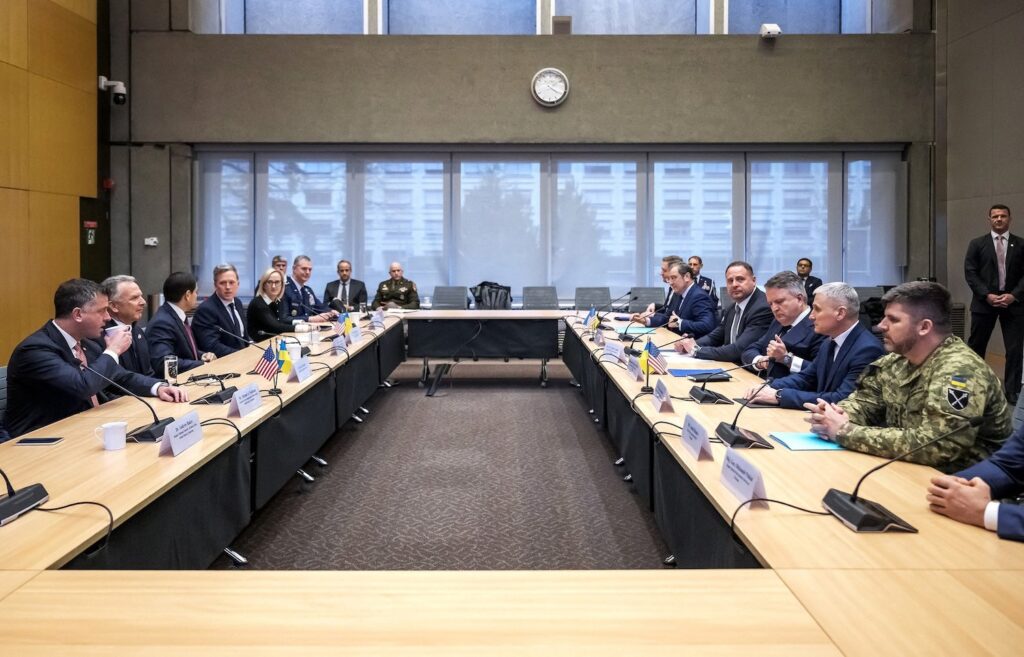In a marathon of diplomatic processes and intensifying negotiations, new channels of dialogue have opened and efforts toward a mutually beneficial solution for the Ukrainian front have been reconfirmed. The initial objections and ambivalence that prevailed over Donald Trump’s 28-point peace plan were overcome once it was agreed that work would focus on a new proposal bearing the European seal. Specifically, after private contacts in Geneva between American, European, and Ukrainian officials, messages of optimism were sent from every direction with the conclusion that, for the first time, the talks were so constructive that they elevated the overall proceedings to productive levels.
What changes from here on in the peace processes for Ukraine and why aren’t they characterized as a fiasco this time? It would be a fiasco if situations and patterns from previous months were repeated again with the extension of an uncertain condition. This time, however, the American delegation appeared open to reformulation, with European objections to the so-called gray areas of the plan being heard. Specifically, Trump’s statement that the proposal is not final seemed to indicate his delegation’s intentions, as indeed the proposal leaked by Reuters, which Europe presented, had its own contribution to reshaping terms.
Geneva: From diplomatic thriller to smiles
Points such as the limit on military forces that Ukraine would maintain in peacetime, from 60,000 proposed by the US to reach 80,000 proposed by Europe, as well as security guarantees with the implementation of treaties reminiscent of NATO’s Article 5 framework, were the promoted points by the EU for plan reform. America didn’t appear negative, as evidenced by the general stance of American Secretary of State Marco Rubio, who focused on the “tremendous” progress, as he characteristically said, that has been achieved.
Similarly, Ukrainian President Volodymyr Zelensky’s side spoke of the most productive processes ever recorded while satisfaction prevails in Europe. From where the situation in Geneva tended to develop into a thriller with the American president intensifying pressure with ultimatums and accusing Kyiv of ingratitude, while Zelensky proclaimed the need to maintain his country’s dignity, the mini diplomatic crisis appears to have been averted.
At this moment, the issue is how the processes on the peace plan will develop, whether Ukraine will have managed to give its response to Trump by Thanksgiving Thursday, and what will apply to the issue of ceding eastern territories to the Russians – something that dangerously dynamited the climate between the EU and US, both during the G20 Summit and in Switzerland, with the Commission President placing an informal veto so that this specific condition wouldn’t even be brought to the forefront.
Ukraine: The main axes of the European proposal to end the war
The counter-proposal from the three European powers covers four central pillars: Ukraine’s security and sovereignty, reconstruction and economic development, Russia-West relations, and humanitarian issues.
The 28 points of the proposal follow in detail:
- Ukraine’s sovereignty will be reaffirmed.
- A comprehensive and complete non-aggression agreement will be achieved between Russia and Ukraine as well as NATO. All ambiguities of the last 30 years will be resolved.
- Point 3 of the US plan is deleted, as Sky News reports. A draft of it seen by Reuters stated: “There will be an expectation that Russia will not invade its neighbors and NATO will not expand further”.
- After signing the peace agreement, a dialogue between Russia and NATO will be convened to address all security issues and create a de-escalation environment, ensuring global security and increasing connectivity possibilities and future economic opportunities.
- Ukraine will receive strong security guarantees.
- The number of Ukraine’s military personnel will be limited to 800,000 in peacetime.
- Ukraine’s NATO membership depends on alliance members’ consensus, which doesn’t exist.
- NATO agrees not to permanently station troops under its command in Ukraine in peacetime.
- NATO fighter aircraft will be stationed in Poland.
- US guarantee reflecting Article 5:
a. The US will receive compensation for the guarantee.
b. If Ukraine invades Russia, it loses the guarantee.
c. If Russia invades Ukraine, besides a strong coordinated military response, all global sanctions will be restored and any recognition of new territory and all other benefits from this agreement will be revoked.
11. Ukraine is eligible for EU membership and will gain short-term preferential access to the European market while its application is evaluated.
12. Strong global reconstruction package for Ukraine, including, among others:
– Creation of Ukraine development fund for investments in high-growth sectors such as technology, data centers and artificial intelligence efforts.
– The United States will collaborate with Ukraine for joint restoration, development, modernization and operation of Ukraine’s natural gas infrastructure, including pipelines and storage facilities.
– Joint effort for reconstruction of war-affected areas, aiming to restore, rebuild and modernize cities and residential areas.
– Infrastructure development.
– Mining of minerals and natural resources.
– The World Bank will prepare a special financing package to provide funding for accelerating these efforts.
- Russia will be gradually reintegrated into the global economy.
a. Sanctions lifting will be discussed and agreed upon gradually and case by case.
b. The United States will enter into a long-term economic cooperation agreement aimed at mutual development in energy, natural resources, infrastructure, artificial intelligence, data centers, rare earths, joint Arctic projects, as well as various other mutually beneficial business opportunities.
c. Russia will be invited to rejoin the G8.
- Ukraine will be fully reconstructed and financially compensated, including through Russian state assets that will remain frozen until Russia compensates Ukraine for damages suffered.
- A joint security working group will be established with participation from the US, Ukraine, Russia and Europeans, aimed at promoting and implementing all provisions of this agreement.
- Russia will legislatively establish a non-aggression policy toward Europe and Ukraine.
- The United States and Russia agree to extend treaties on non-proliferation and control of nuclear weapons, including New Start.
- Ukraine agrees to remain a non-nuclear state under the NPT (Nuclear Non-Proliferation Treaty).
- The Zaporizhzhia nuclear plant will be restored to operation under International Atomic Energy Agency (IAEA) supervision and generated energy will be distributed equally between Russia and Ukraine in a 50-50 ratio.
- Ukraine will adopt EU rules regarding religious tolerance and protection of linguistic minorities.
- Ukraine commits not to reclaim its occupied sovereign territories by military means. Negotiations for territorial exchange will start from the contact line.
- Once future territorial arrangements are agreed upon, both the Russian Federation and Ukraine undertake not to change these arrangements through use of force. Any security guarantees will not apply in case of violation of this obligation.
- Russia will not impede Ukraine’s use of the Dnieper River for commercial purposes and agreements will be reached for free grain movement through the Black Sea.
- A humanitarian committee will be established to resolve pending issues:
a. All remaining prisoners and bodies will be exchanged based on the “all for all” principle.
b. All civilian prisoners and hostages will be returned, including children.
c. A family reunification program will be implemented.
25. Ukraine will conduct elections as soon as possible after signing the peace agreement.
26. Measures will be taken to address the suffering of conflict victims .
27. This agreement will be legally binding. Its implementation will be monitored and ensured by a Peace Council, chaired by Donald Trump. Sanctions will be imposed in case of violations.
28. Once all parties agree to this memorandum, a ceasefire will immediately take effect, with withdrawal of both sides to agreed points, so that agreement implementation can begin.
Key points of Trump’s plan
According to Trump’s proposed plan, Ukraine’s independence will be confirmed and a comprehensive non-aggression agreement will be concluded between Russia, Ukraine and Europe. Dialogue will be conducted between Russia and NATO, mediated by the United States, to resolve all security issues. Ukraine will receive credible security guarantees, while the size of Ukrainian Armed Forces will be limited to 600,000 people.
NATO agrees not to deploy troops in Ukraine, while European fighter aircraft will be stationed in Poland. Ukraine remains eligible for EU membership and will receive short-term preferential access to the European market.
Ukraine reconstruction package
A strong global package of measures for Ukraine’s reconstruction is also envisioned, which will include creating a Development Fund for investments in rapidly developing industries, including technology, data centers and artificial intelligence. The US will collaborate with Ukraine on rebuilding, developing and modernizing natural gas infrastructure, including pipelines and storage facilities.
Nuclear weapons and legal binding
Regarding nuclear weapons, the United States and Russia will agree to extend the validity of treaties on non-proliferation and control of nuclear weapons, while Ukraine agrees to remain a non-nuclear state. The agreement will be legally binding and its implementation will be monitored and guaranteed by the Peace Council, headed by the American president.
Once all parties agree to the memorandum, the ceasefire will take effect from the moment both sides withdraw to agreed points for agreement implementation to begin.



